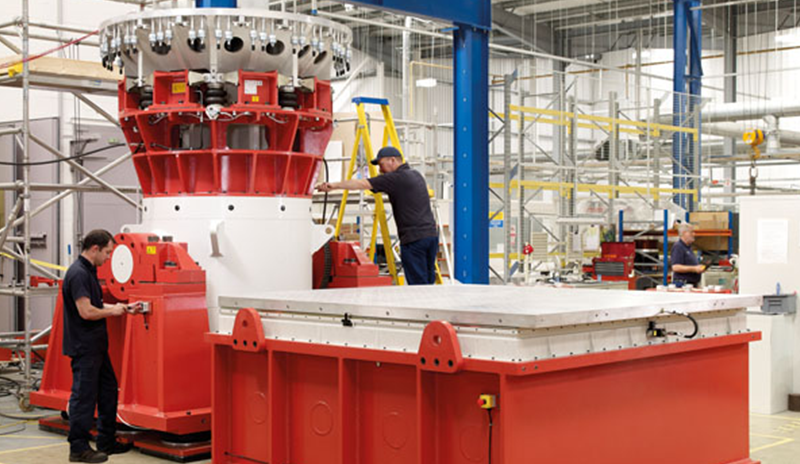The article is based on HBK LDS’ many years of experience in the world of vibration, and the plethora of problems that can be encountered during the vibration testing of components and assemblies. This time we look at vibration shakers and maintenance including:
- Air-cooled vibration shakers
- Water-cooled vibration shakers
- Maintenance
Air-cooled vibration shakers
LEARN MORE
HBK LDS ELECTRODYNAMIC SHAKER
Dirt, dust and ambient temperature
If the shaker (vibrator) is operated in dirty and dusty environments, the air vents can become blocked causing the shaker cooling to become impaired.
If the shaker is operated at high ambient temperatures (above 30°C), the shaker coils will overheat at full force. The cooler the air, the longer the life of the shaker will be. If temperatures cannot be kept below 30°C, the shaker should be de-rated in force.
Air cooling hoses
Hose lengths should be as short as is practical. Where the standard supplied length of hose is deemed too short, our engineering team should be consulted as to the requirements for long ducting lengths. It is worth noting that long ducts can increase the pressure drop seen by the fan, and thus restrict the flow of air to the shaker.
A kinked or damaged cooling hose can cause a reduction in the flow of air to the shaker, leading to increased running temperatures, reducing the life of the shaker.
Air supply and quality
The air supply should conform to ISO 8573-1: class 1.7.1, with a maximum particle size of 0.01 microns and remaining oil content of 0.01 ppm. Water or oil traps should be fitted if deemed necessary.
Particularly where air compressors may turn off overnight, consideration should be given to fitting a safety switch to ensure that the shaker cannot run without an air supply being present.
Water-cooled vibration shaker
Continuous running
Due to the gradual heating of the body, standard water-cooled shakers should not be run continuously. Optional body cooling is available for V964 shakers, which allows for continuous running scenarios.
When running the vibration test system using the economy tap, the shaker will not be able to produce full force; full field will be required in order to do this.
Cooling unit, oil
Raw water supplied to the cooling unit should always be within specification for flow and temperature. Otherwise it will cause the system to trip as the cooling unit coils will not be able to reject all their heat. The cooling unit tank must always be full, if not, damage to both the shaker and the cooling unit may occur.
Where the cooling unit is sited above or below the shaker, special consideration is required for how the water and oil are returned from the shaker.
- Below the shaker: siphoning can occur from the shaker.
- Above the shaker: scavenging is required for the oil. Oil scavenging should also be considered if supply hoses are unusually long.
LDS Warranty and Maintenance
LEARN MORE
HBK LDS SERVICES AND MAINTENANCE
Programming of maintenance
Regular checks and maintenance activities should be carried out as recommended in the user manuals. Maintenance should always be carried out by suitably trained personnel.
Calibration
Items such as accelerometers, which control test levels, should be checked regularly to ensure that they are calibrated and working correctly.
Drive and field cables
All drive and field cable connections should be checked for tightness, as loose connections can inject transients into the test item.
Oil and water supplies
To maximize the life of the vibration test system, oil and water should be changed at the intervals recommended in the user manuals.
Air supply
The air supply should always be within specification, as dirty or wet air can cause the pneumatic regulators to stick.
Replacement parts
To avoid problems caused by stoppages, a stock of spare parts should always be maintained as recommended in the user manuals. HBK LDS approved parts should always be used as many are safety critical, and most will affect the performance of the equipment.
Lifting equipment
Adequate lifting facilities must be available both for mounting payloads and for servicing the vibration test system.
Cleanliness
The equipment, and all areas surrounding it, should be kept as clean as possible. Always keep the shaker clean as swarf can damage the top seals, and if pulled into the shaker body, can cause electrical shorts, damaging the shaker.
Cables
Cables should always be routed so as not to obstruct walkways. No cables should be left where they can be walked on.
Further guidance on safe practices and hazards is given in the relevant user manuals.
Related Articles
- Vibration Testing – Dos and Don’ts: Site Design
- Vibration Testing – Dos and Don’ts: Shaker Operation
Related Products


